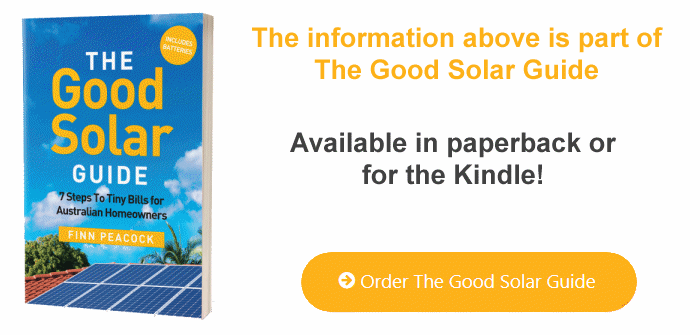Choosing Solar Components – A Summary
← Solar Monitoring Systems | The Good Solar Guide Contents | Getting Quotes →
The following is a brief summary of what was discussed in the choosing your solar hardware section of this guide.
Solar panels
- Solar panels should last for 25 to 30 years. Australian roofs are harsh environments, so quality is key. The difference in price between 5 kW of reputable panels and 5 kW of junk can be as low as $600, so buying quality doesn’t have to break the bank.
- If you choose one of the brands on the chart in this section (or better – the up-to-date one online: solarquotes.com.au/pchart), you’ll get what I consider to be a reputable brand. Although there are no guarantees in life, I believe these brands are much more likely to last and that it is more likely the companies will be around to service any warranty issues.
- Unless my online tool shows that your roof is too small to fit enough ‘regular efficiency’ panels for your system, you don’t need to buy super-efficient, super-expensive panels (unless you simply like owning the best).
- As for the other panel specifications, don’t sweat it. Good panels are all similar in this regard.
- Make sure you understand solar panel warranties, which I go through here: solarquotes.com.au/warranties.
- If you buy solar panels without PLO then if one panel in a string has reduced output, it can drag all the panels down to its level. PLO is essential if you have partial shade, or a complicated roof that faces in more than two directions.
- PLO can be achieved with micro-inverters or DC optimisers, but it will add $1,500 to $2,000 to the cost of a 5 kW system. PLO can also be achieved with solar panels that have Maxim optimiser chips embedded. This only adds $750 to $1,000 to the cost of a 5 kW system.
- Make sure your panels have all the certifications you need for special conditions, such as salt-mist resistance.
Inverters
- The inverter is the most likely component to fail in the first ten years, so focus on quality and go for brands on the right-hand side of the chart in this chapter (or better – the up-to-date one online: solarquotes.com.au/ichart). The difference between the budget and premium brands is $700 to $1,000 for a 5 kW inverter.
- Get a 10-year warranty with your solar inverter – even if it costs you an extra $400 to extend it from 5 years.
- Get 33% more panels than your inverter is rated at. This is the most cost-effective way to buy solar and it won’t negatively affect performance in any meaningful way.
Batteries
- If you plan to add batteries later, there’s no need to buy a special inverter. You can easily add batteries to any solar inverter with a technique called AC coupling.
- If you plan to get solar batteries and an electric car in the future, look for panels with an efficiency that will allow you to fit at least 9 kW on your roof, even if you’re not installing 9 kW now. Don’t be afraid to use all roof directions.
- If you want apocalypse-proof backup, make sure any quoted system states that the batteries can charge from the solar during a grid outage.
Monitoring
- A good third-party monitoring system will alert you almost immediately if your system fails or under-performs. Don’t wait for your quarterly bill to learn that your solar savings have stopped or reduced.
- Third-party monitoring will monitor your consumption so that you can understand what appliances are still using grid electricity and identify opportunities to reduce grid consumption.
- A good solar monitoring system will tell you what your optimum battery size is and how much it will save you, so you can invest in the right battery at the right time.
- In the near future I expect third-party monitoring to advise you proactively if you are on the best tariff.
- I personally consider good third-party monitoring an essential addition to any solar system.
← Solar Monitoring Systems | The Good Solar Guide Contents | Getting Quotes →
Questions or feedback about the content on this page? Contact me.
